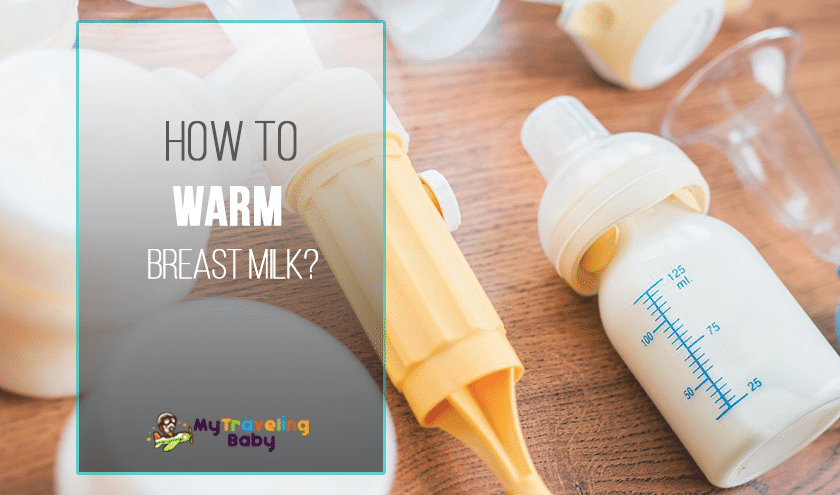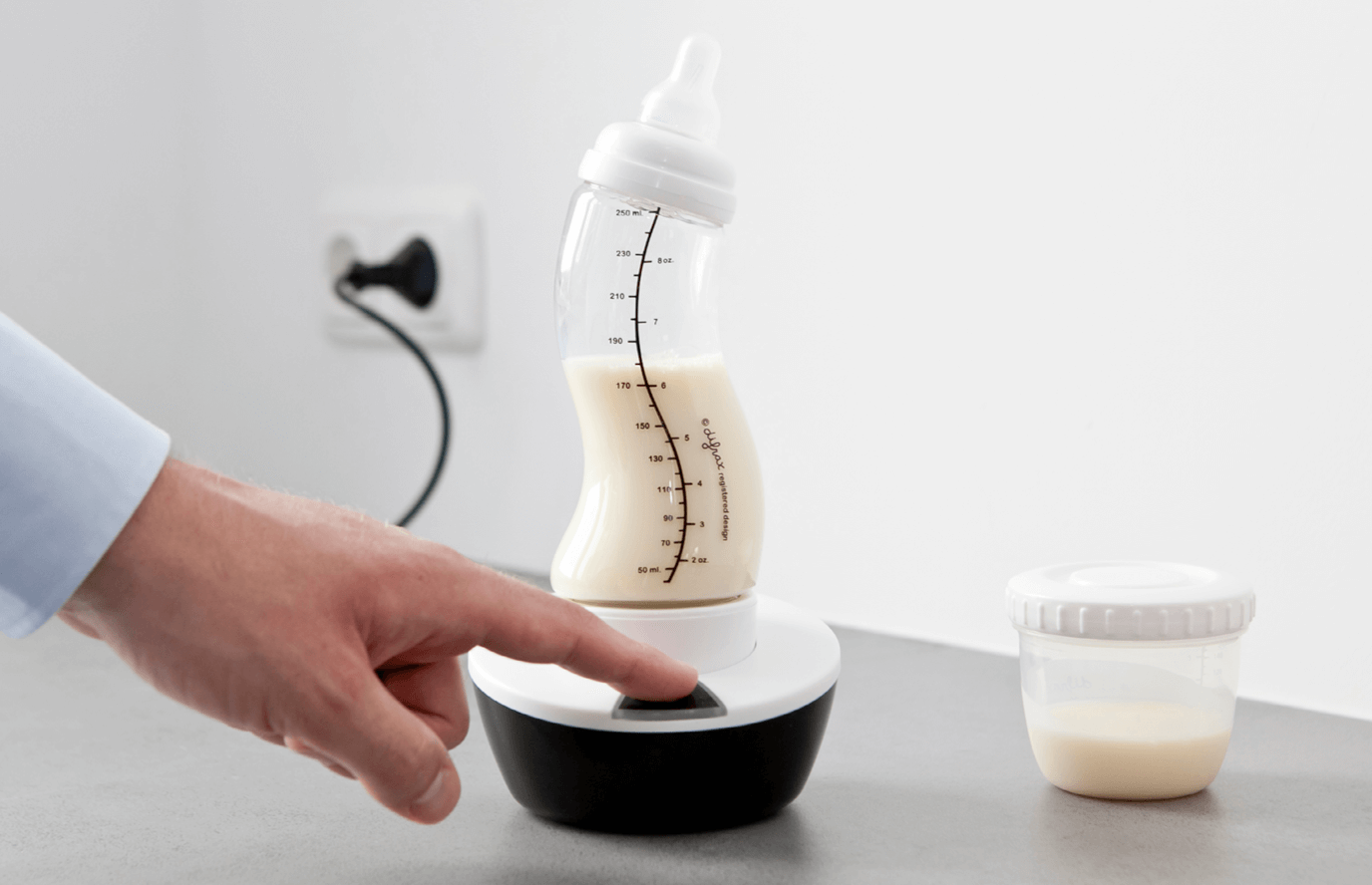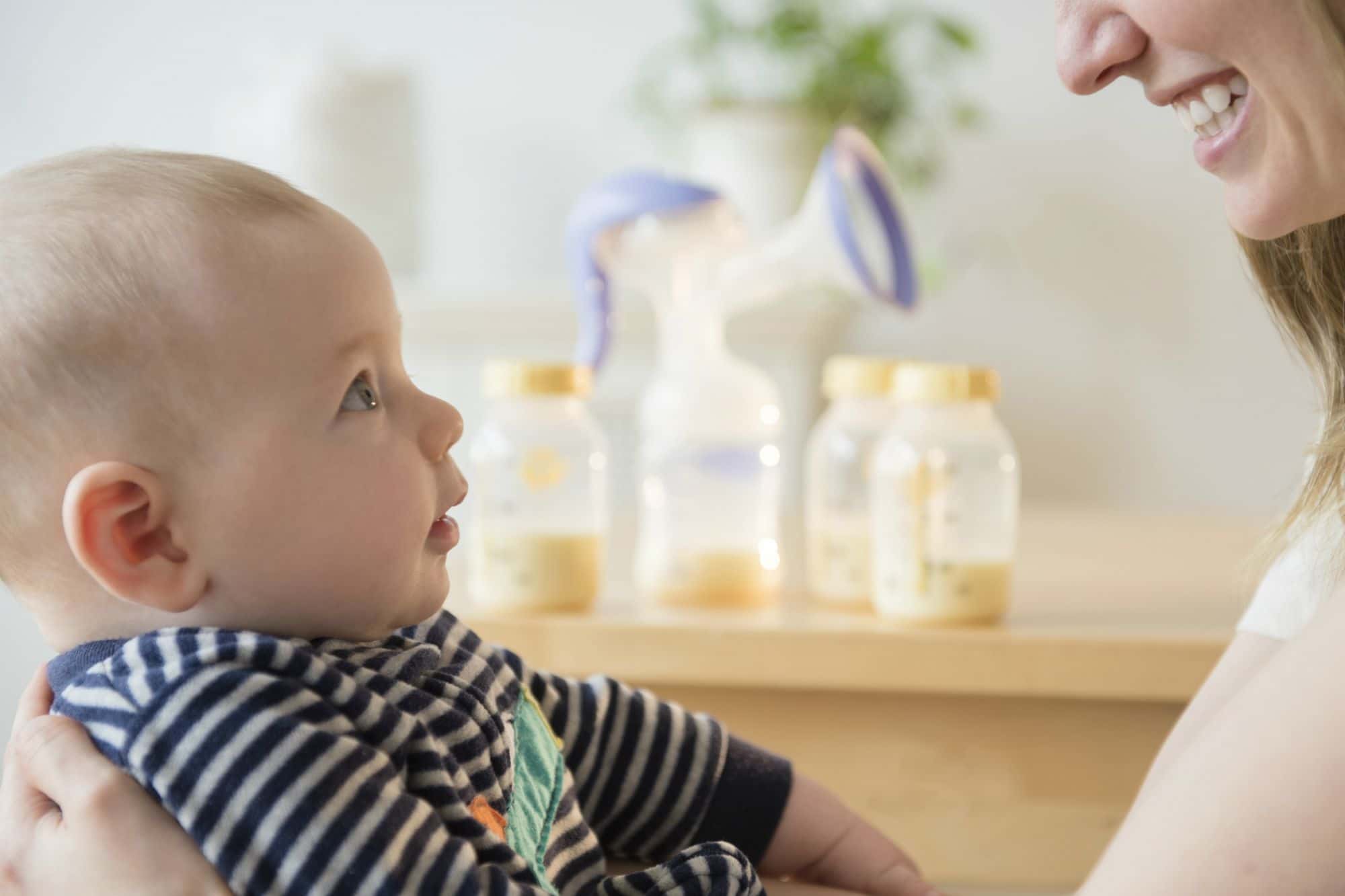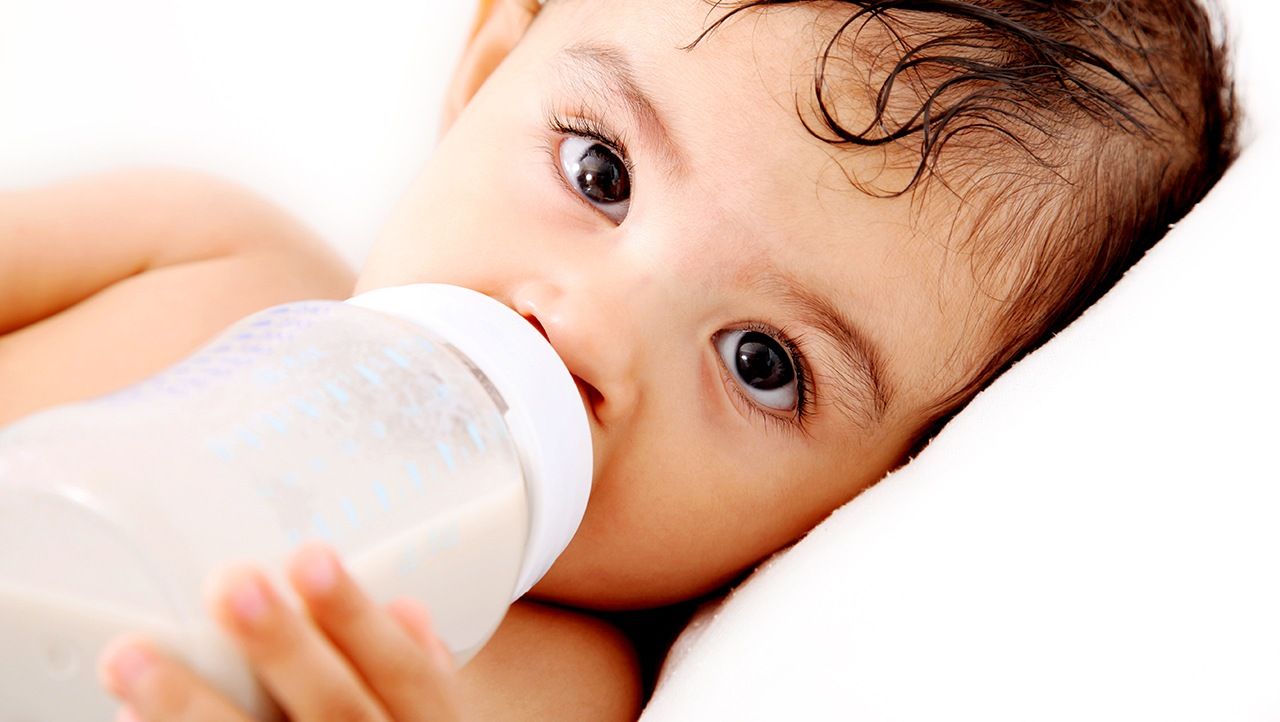
It’s a well-known fact that breast milk is the most perfect baby food that there is. It contains things such as healthy enzymes and immunity-boosting antibodies that the scientists simply cannot replicate.
To put it simply, it’s a liquid that provides the most ideal nutrition for an infant. Let’s take a quick look at some of the most significant benefits of feeding the baby with this precious liquid.
Breast Milk Benefits
- It protects against eczema and allergies. This is especially beneficial in case there’s a history of these diseases in your family. Proteins that are present in soy milk formulas and cow’s milk are capable of stimulating an allergic reaction, while the proteins that are present in the breast milk are a lot easier to digest.
- It causes less constipation, diarrhea, and stomach upsets than formula. The reason behind this is in the fact that the baby’s body finds breast milk much easier to break down.
- It reduces the risk of respiratory infections, ear infections, gastroenteritis, inflammatory bowel disease, urinary tract infections, and various viruses. The incidences of colds and pneumonia are reduced among babies that have been fed with the milk of their moms. Formula-fed infants are two to three times more likely to experience ear infections and five times more likely to suffer from respiratory tract infections and pneumonia than the babies fed with breast milk.
- It reduces the risk of SIDS. Even though the connection is still unclear, the babies that have been fed with this liquid are less prone to sudden infant death syndrome.
- It protects against diseases such as Hodgkin’s lymphoma, type-1 diabetes, and spinal meningitis. This is because the mother passes her white blood cells and immune factors to the child through her milk.
- It can make the baby smarter. Although the research is still inconclusive, some studies have shown that babies fed with this kind of fluid have higher IQ scores later in life. This is because of fatty acids present in the breastmilk – these are considered to be significant brain boosters. It can also assist with preventing obesity later in life.
- In addition to health advantages, the economic benefits also deserve a mention. A study that was conducted more than a decade ago has shown that families who opted for using breast milk instead of the formula one have saved around $1,500 in expenditures in the first year alone. The fact that this kind of liquid reduces the chances of various illnesses also leads to lower health care costs.
- Another advantage worth mentioning is that using breast milk also brings environmental benefits. With human milk, there are no packages involved, unlike with the infant formulas that require packaging which eventually ends up deposited in landfills.
Expressing Breastmilk
Since this article focuses on warming milk that has been expressed by means of using a manual or electric pump, let’s also have a look at the benefits of using this method. Expressing breastmilk can be useful if:
- You, as a mother, would like to produce more milk – expression is well-known as something capable of boosting the milk supply. If you decide to engage in it in the early days (to make extra), it could very well make it easier for you to produce more milk later on.
- You can’t be with your child at all times – you need to go back to work, or your baby needs to be in special care.
- Your baby is unable to take the liquid straight from your breast or can’t suckle well. Expressing can also help in case you have a condition that prevents you from engaging in breastfeeding.
- Your breasts feel uncomfortable and engorged. In case you’re having this issue; expressing the liquid with a high-quality breast pump, whether it’s a manual or electric model, can be of great help.
Warming the Breast Milk
If you’re a mother who’s into breast pumping, you probably know that the journey the milk takes from your breasts to your infant has quite a few pit stops. One of these stops is usually the fridge, which is why it’s of crucial importance to learn the ways in which you can safely and effectively warm the breast milk.
In the following paragraphs, we’ll try to find answers to the following frequently asked questions:
- Why is warming breast milk so important
- How to do it in a way that will preserve the milk’s crucial nutrients
- What to do with unused milk that you warmed up
Why is Warming Breast Milk So Important?
Giving your infant cold breast milk is an entirely safe thing to do. However, an important thing to mention here is that the babies are used to body-temperature liquid since this liquid usually arrives straight from the mother’s breast.
Another important topic is the energetics, or, to put it simply, the way in which the food’s temperature has an effect on the way it is digested.
Typically, room-temperature food is considered to be more nourishing and way easier to digest when compared to cold meals. This leads us to a conclusion that warming breast milk makes it much easier for the baby to digest it.
What’s the Ideal Temperature?
Once you warm it, you have to swirl the breast milk carefully and slowly squeeze a couple of drops onto your wrist and test its temperature. The liquid should feel somewhat neutral against your skin – i.e., not overly hot and not excessively cold. Have a look at the following list of temperature ranges – it should help with determining the proper temperature of the fluid:
-
32 to 78º F
Feeding the baby with milk that’s within this temperature range is perfectly safe, although it isn’t actually optimal for the infant’s taste preferences and digestion. Some babies might even refuse to consume it.
-
98.6º F
This would be the average body temperature and also the one that should be your target when you’re warming the liquid. Not only is the fluid of this warmth close to the one coming out of mother’s breast, but it’s also lukewarm enough for its pre/probiotic qualities and nutrients not to get destroyed.
-
99º to 105º F
Although slightly higher than the recommended one, this temperature range is still ok. It is still somewhat lukewarm and should pose no danger to the essential nutrients within the liquid.
-
106º F and more
We highly advise against heating the milk beyond the above-mentioned temperatures. Not only can it harm the infant’s mouth, but the liquid that’s this hot also deteriorates in quality. So, try to avoid heating the liquid beyond the recommended ranges.

How Do I Warm Breast Milk?
Tackling this task can be done in four different ways, all of which preserve the essential nutrients. Take a look at our straightforward step-by-step guides and learn how to warm up breast milk.
Method #1 – Running water
- Step #1: Run warm tap water. Make sure that it’s not overly hot.
- Step #2: Take a bottle in which you keep the fluid and place it under the running water.
- Step #3: Rotate it for a couple of minutes under the stream of water to warm up its contents.
- Step #4: Gently swirl the bottle to mix the contents.
- Step #5: Place a few drops of the fluid onto your wrist to test the temperature before giving it to your child.
Although this method is considered to be highly effective, it’s not exactly the most environmentally-friendly approach. If you can, you should opt for a technique that uses standing warm water, and avoid wasting tap water on warming the bottle.
Method #2 – Warm under the bath
- Step #1: Take a bowl and fill it with warm water.
- Step #2: Take your bag or bottle containing breast milk and place it into the bowl. Leave it there for a couple of minutes.
- Step #3: Gently swirl to mix the bag’s/bottle’s contents.
- Step #4: Just like in the previous method, test the temperature by placing a couple of drops onto your wrist.
Method #3 – Countertop warming
This is by far the easiest method and one that doesn’t require any additional equipment. Simply place your closed bottle onto your kitchen’s countertop and wait for the liquid to reach the room temperature. Mix it and test it on your skin before feeding the infant.
Although many mothers leave the bottle to stand there for up to eight hours, it is not advisable to go higher than two hours. This is especially significant when it comes to feeding infants with compromised immune systems.
Method #4 – Bottle warmer
In order to learn how to heat up the milk by using a bottle warmer, you’ll have to consult the user manual of your own specific device – instructions vary from one brand to another. .

What Should I Avoid?
Mother’s milk is not a simple mix of macronutrients and micronutrients, as it is also swarming with “live” elements. The thing that makes it so unique is the fact that it’s full of digestion-enhancing, immune-supporting, bacteria-fighting, microbiome-building cells. It also has quite a lot of probiotics and enzymes.
A particular study has shown that overheating breast milk can easily harm or even destroy heat-sensitive nutrients and some of the above mentioned live components. A temperature that’s too high can easily reduce the overall folate level within the liquid for more than 20%. Moreover, heating the liquid above 143º F can also lead to the death of its white blood cells and helpful probiotic bacteria.
It is no wonder that many people call breast milk liquid gold. A caring mother will want to preserve these powerful nutrients in any way she can, and the best way to do it is to learn how to warm her milk correctly. Let’s have a look at a couple of rules that will assist you in preventing overheating:
-
Rule #1 – Don’t use a microwave for warming
Using a microwave to warm breast milk should be avoided at all costs. The reason behind this is in the fact that these devices don’t heat the liquids evenly – there’s always a chance for the formation of hot pockets in the fluid. These hot spots are more than capable of hurting your baby’s mouth. Moreover, bottles that get overly hot tend to explode, and you certainly don’t want that to happen.
-
Rule #2 – Water should never be too hot
When warming your precious mother liquid, avoid using boiling water – it can lead to dangerous overheating. Heating bottles to more than 120º F can cause a significant deterioration of the liquid’s quality. As we already mentioned, try to use lukewarm water whose temperature is between 98º and 105º F. This is more than enough to warm the fluid to typical body temperature.
-
Rule #3 – Don’t use a pan to do the warming
The first reason for avoiding this is that it exposes the liquid to outside influences and bacteria. The second is that it makes really challenging to control the temperature. There’s also the risk of overheating, which, as we said, poses a risk to the baby’s health and reduces the milk’s quality.
How Long Can I Use the Heated Breastmilk?
The milk that you have freshly pumped and expressed can be left at the standard room temperature for the duration of 6 to 8 hours. However, the heated liquid that previously spent some time in the fridge has a much shorter shelf life. Once you warm it up to the room temperature, make sure to use it within the following 2 hours.
An important thing to keep in mind here is that these are just recommendations since many mothers leave their precious liquid out for longer.
It’s just the more cautious and safer option and one which you should especially go for if your child has a compromised immune system.
Due to this small time window, it’s always a good idea to warm, thaw, and store your milk in small amounts – around two or three ounces per one bottle or bag. Only warm the liquid that you will use to prevent waste since you can always heat up some more when required.

Can Already Heated Milk be Reheated?
If possible, avoiding feeding your infant with leftover milk is always the best decision. Once the baby has already consumed some of this fluid from a bottle, there’s a good chance that his or her saliva will introduce bacteria into the liquid.
However, due to the fact that breastmilk is liquid gold, many mothers just can’t allow it to go to waste. Experts agree that the risk is pretty low – some studies have shown that the antibodies present in this liquid can assist in fighting bacteria.
Once again, the best course of action is always to store and feed in smaller amounts – it’s the simplest solution to avoiding these issues. If you still decide to use remaining liquid, make sure to use it within the following couple of hours. You should also have a talk with your healthcare provider since he or she could tell you what’s best for your kid.
An important note – a child whose immune systems has been compromised should not be fed with rewarmed milk. In cases such as these, discarding the unused liquid is the best decision.
Can I Put a Bottle of Milk into the Fridge Once I’ve Already Warmed It?
As we already said, the breast milk that was warmed should be used within the following few hours. Some mothers prefer to leave the liquid on the kitchen’s counter, which means that they don’t need to do the reheating at all. On the other hand, some moms will simply refrigerate it.
The choice is yours and yours only, although refrigerating the unused liquid is still the best idea. This is especially important if you’re outdoors or inside a sunny (and therefore warm) room.
Signs of Spoilage
Although it’s outstandingly resilient, this precious liquid can still go bad. These are the most common signs of deterioration:
- A change in color or texture
- A strange taste
- A foul smell
- When swirled together, the fluid refuses to mix
The Taste of Defrosted Milk
Sometimes, breast milk that has been defrosted can have a soapy, metallic taste, as well as the unpleasant smell. This, however, doesn’t mean that the liquid has gone bad – you will not have to discard it.
This taste is, actually, the result of a specific enzyme called Lipase, which is present in this fluid and has a tendency to break down fats during storage. This kind of milk is entirely safe to feed the baby with, although there is no guarantee that the infant will like its taste and can easily reject it.
Storing the Milk in the Refrigerator
To safely store the expressed fluid inside your fridge, follow these guidelines:
- Make sure to store it in the coldest part of your fridge. This would be at the back of the refrigerator, on the shelf that is above your vegetable compartment. Avoid storing the milk in a refrigerator that doesn’t work properly or in the fridge door, since this part doesn’t hold a consistent temperature.
- Smaller amounts of expressed liquid can be added to the very same container, but only if the fluid you’d like to add has already been cooled in the refrigerator. Make sure to avoid adding body-temperature milk to the one that has already been stored.
- Store the liquid in clean storage bags and bottles that have been manufactured from BPA-free materials. In case you’ve never heard of this term before, BPA is a chemical that was once widely used in the industry but now isn’t because of its unknown long-term effects.
- Don’t forget to clearly label the containers – write down the date at which the fluid was expressed. In case you’ll be giving it to a child-care provider, include the name of your baby.
Using the Freezer Instead of the Refrigerator
The following tips will help you learn how to use a freezer to store the breastmilk properly:
- Once expressed, the liquid should be frozen as soon as possible.
- It’s essential to check if the storage containers that you’re about to use can be used in the freezer at all. The reason for this is that some products, such as, for example, glass bottles, are prone to cracking at extremely low temperatures.
- The bags and bottles should never be filled more than 3/4 full. This is because breast milk can expand during the process of freezing.
- Another crucial point to consider is the location inside the freezer. We advise storing the bottles and bags at the back since that’s where the temperature has the best consistency. Keeping the bottles away from the walls of self-defrosting freezers is also essential.
- Just like with the refrigerators, avoid adding body-temperature milk to the already frozen milk. Add only milk that was first cooled in the fridge.
- Do not tighten the bottle lids or caps until the fluid is in the entirely frozen state.
Conclusion
As you can see, warming breast milk is not difficult or dangerous when it’s done properly. It is, actually, quite an easy thing to do, although it’s very important to take precautions in order to make sure that the liquid doesn’t overheat. This can result in milk losing its beneficial purposes and becoming too hot for your baby’s mouth.
No matter which method of warming you decide to go with, make sure that you’re using clean, chemical-free bottles and that you put the warmed milk to use as soon as possible.
Don’t forget about the signs of spoilage we’ve mentioned and make sure to properly store the fluid in your fridge or freezer if needed. We hope we’ve been helpful – good luck!



